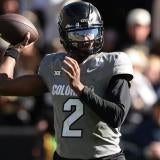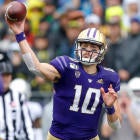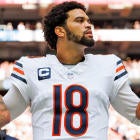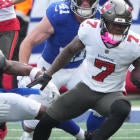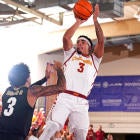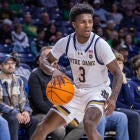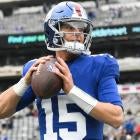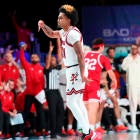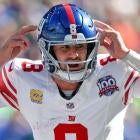LSU's Joe Burrow is a first-round talent, the only question is how early in the first round he'll hear his name called. Three months ago, Burrow was a likely Day 3 pick while Oregon's Justin Herbert was considered one of the best passers in college football. Herbert has improved after returning for his senior season but many of the concerns that plagued him in 2018 remain.
Meanwhile, Washington's Jacob Eason, who has played very little football the previous two seasons, has been impressive through the first half of the season, including Saturday's loss to Herbert and the Ducks. At the other end of the spectrum: Utah State's Jordan Love has had a forgettable 2019 campaign though some of the blame falls to his receivers, who have dropped countless passes through six games.
Justin Herbert, Oregon
Justin Herbert is an enigma. We've been talking about him now for more than a year, and repeating many of the same talking points: His arm strength is otherworldly, his measurables -- 6-foot-6, 237 pounds, insane athleticism and an ability to make plays with his feet -- check all the boxes. And for as much as we want to like him the reality is that he has yet to put it all together.
Sure, there's the five-touchdown performances against Montana and the 79.1 completion percentage against Stanford, but Herbert faced virtually no pressure against the Grizzlies and one-fifth of his throws have been screen passes, which help account for the uptick in his completion percentage (it's up from 59.4 percent in 2018 to 68.1 percent this fall).
The good news is that Herbert went on the road on Saturday and helped lead his team to a critical conference win against a tough Washington team. The less-than-good news is that Herbert continues to make many of the same mistakes that would give me serious doubts about taking him with a top-10 pick if I was an NFL general manager desperate to find a franchise quarterback.
Again, the arm strength is ... my goodness:
Herbert 5 for his first 5. They're in the red zone now. This was his best throw so far. No substitute for arm strength. pic.twitter.com/VcS7FNcZQX
— JG (@JoeGoodberry) October 19, 2019
But things get messy when Herbert faces pressure -- real or otherwise -- and his accuracy becomes a concern when he doesn't set his feet:
He hurries this throw and missed a crucial third down conversion. Gotta be better when pressured. pic.twitter.com/hyJ8zis0qf
— Ian Wharton (@NFLFilmStudy) October 19, 2019
That's a throw Herbert has to convert 100 times out of a 100; it's an easy first down, it keeps the drive going, but instead, the Ducks were forced to punt. A series later it happened again; Herbert got jittery in the pocket despite being well protected and facing just a three-man rush, then throws on the run and short-hops a pass in the middle of the field to a wide-open target:
He's having a dreadful day so far. Second time leaving an open intermediate pass short. pic.twitter.com/pAeimdmaDr
— Ian Wharton (@NFLFilmStudy) October 19, 2019
And just when you're ready to throw up your hands and give up on Herbert despite all that talent, he does this, late in the 2nd quarter and a play after airmailing an easy throw to the sidelines:
Great throw from Herbert up the middle of the field. Does so in the face of pressure. Tough play. pic.twitter.com/aRvtVqDEcb
— Ian Wharton (@NFLFilmStudy) October 19, 2019
The second half was more of the same -- a couple big-time NFL throws sandwiched around some easy misses, a ton of screen passes, and a healthy running game to keep the offense moving. Herbert seems most comfortable on RPO/quick-strike play calls, where the ball is out of his hands quickly, the reads are defined, and the threat of pressure is minimal. He's also the beneficiary of a strong running game and stout defense.
On Oregon's 8-play, 70-yard game-winning drive, Herbert attempted two throws: an RPO/slant and a screen pass that went for a touchdown. Yes, his talents are undeniable but he has too many question marks to be considered a top-10 pick, at least right now.
Jacob Eason
Eason was the best quarterback on the field Saturday when the Huskies hosted Justin Herbert and the Oregon Ducks. Both players look like NFL quarterbacks and possess two of the strongest arms in college football. Eason finished 23 of 30 for 289 yards, 3 touchdowns and no turnovers, and those numbers would've been even better if he hadn't been victimized by several drops, including on the Huskies' final offensive play of the game.
Eason got things going early in the 2nd quarter with this 48-yard dime to Jordan Chin:
It’s raining 💣s from Jacob Eason at Husky Stadium#UOvsUW | https://t.co/MhtmrPMgbw pic.twitter.com/Nr3HIgILu8
— Seattle Times Sports (@SeaTimesSports) October 19, 2019
And that came against a stout Ducks defense, one that hadn't previously allowed a 40-plus-yard play all season. Unlike Herbert, Eason looked much more comfortable in the pocket, getting the ball out on time and accurately. Later in the 2nd quarter, he completed this back-shoulder throw that set up a touchdown pass one play later to give Washington a 21-14 halftime lead:
This back shoulder throw from Jacob Eason is incredible. He’s making magic with Hunter Bryant today. pic.twitter.com/4e8RVvPE2G
— Rob Paul (@RobPaulNFL) October 19, 2019
Eason starts the second half by again showing off his arm strength, to get the ball past the underneath linebacker, and accuracy, leading wide receiver Puka Nacua, giving him a half-step on the cornerback all the way to the end zone:
Washington extends their lead! Jacob Eason with a 33 yard TD to Puka Nacua! #Huskies pic.twitter.com/Pp2fYrz3Rr
— #BusinessIsSuspended (@FTBeard11) October 19, 2019
Eason is raw and there's no guarantee he declares for the draft after his junior season, especially since he didn't play last season after transferring from Georgia, but NFL teams are certainly intrigued by his talents.
Joe Burrow, LSU
Joe Burrow is the most efficient quarterback in college football, and he's playing with the most confidence too. He came into Satuday's game against Mississippi State with 25 touchdowns in just six games, which is three short of the LSU season record. Given that he's thrown at least two touchdowns in every game this season -- and is averaging 4.2 a game -- it stands to reason that he'd surpass the previous mark held jointly by JaMarcus Russell and Matt Mauck.
And Burrow needed just three quarters to make it happen. His first touchdown, a 60-yarder to Racey McMath, was the result of a blown coverage. His second touchdown, which came just before the half, was a perfectly thrown ball to Ja'Marr Chase:
And here's Joe Burrow with the 8-yard strike to Ja'Marr Chase for TD No. 27 this season (it's the 9th for Chase).
— Jeff Nowak (@Jeff_Nowak) October 19, 2019
One more to tie JaMarcus Russell and Matt Mauck at the top with 28. pic.twitter.com/fBy7nJnfSb
On LSU's first drive of the 2nd half, Burrow got right back to work. After completing two passes to Chase, Burrow steps up in the pocket to avoid the rush, keeping his eyes downfield the entire time, then lofted this pass to Dillon in the back of the end zone for a 37-yard score.
Plays like this are why Joe Burrow is a Heisman contender. pic.twitter.com/EJXUQi03bW
— CBS Sports (@CBSSports) October 19, 2019
That is a big-time throw and it reinforces a few things: Burrow rarely gets rattled. Instead of bolting, he calmly takes a step towards the line of scrimmage, and just as important, doesn't drop his head losing sight of his downfield options. Then he puts the ball where only his receiver can make a play, but with enough room to make sure he can remain inbounds. Burrow is playing on another level right now.
On the next series, Burrow set the record -- naturally, a play after LSU was flagged for offensive pass interference that would've been good for a TD -- with this relatively easy touchdown pass to Jefferson:
A bit of history for @LSUFootball.
— CBS Sports (@CBSSports) October 19, 2019
Joe Burrow sets the school's single-season passing TD record with his 29th of the year...and it's only LSU's 7th game. pic.twitter.com/n1ZGdWnM6b
The only way Mississippi State could slow Burrow was by pantsing him -- literally. Too little, too late, however; LSU led by 29 points at the time and the game was all but over.
Seriously though, Burrow is the best quarterback in college football right now and he's making a strong case that he's the best draft-eligible quarterback too. He does everything well, he's a sneaky good athlete, and he's doing it all while completing 79.1 percent of his throws. We're only halfway through the 2019 season, not to mention draft season, but no one player has done more for his draft stock in such a short period as Burrow.
Jordan Love, Utah State
Jordan Love is so much fun to watch but he's struggled with consistency this season. His arm strength is unquestioned but his decision-making can be problematic at times. But when Love is on it's something to behold. Like this first quarter throw to Deven Thompkins with three Nevada defenders in the area:
Jordan Love vs Nevada
— Travis Wingfield (@WingfieldNFL) October 20, 2019
He sure is fun to watch throw a football pic.twitter.com/ZLp1dEy2ve
Yes, this is an incompletion but that's an NFL throw and that's all NFL teams will care about when they watch the tape.
But this isn't all on Utah State's pass catchers. Love's accuracy has been an issue all season. He throws a beautiful deep ball, for sure, but the lack of consistency on out routes have plagued him all season. He missed early in the second quarter on a throw that would've moved the sticks, and he's had throws intercepted on those routes because of poor ball placement.
He also has to do a better job of staying in the pocket when there's no pressure. Love does a good job of keeping his eyes downfield, but he'll leave the pocket because of a perceived pass rush that isn't there. And while his athleticism is a plus in most situations, he'll lean on it when he doesn't need to, and that leads to Love making off-balance, on-the-move throws when the alternative is on-balance, from-the-pocket attempts that have a much higher percentage of being successful.
Worth noting: Love has been victimized by drops all season and midway through the second quarter he was just 4 of 16 -- with four dropped passes. Having seen enough, Love decided to lean on his athleticism and take matters into his own hands:
If you’re watching Jordan Love’s box score, you’re doing it wrong. pic.twitter.com/PgyRKSozG3
— Travis Wingfield (@WingfieldNFL) October 20, 2019
Then, several plays later, Love throws a rope to his tight end for a touchdown:
Jordan Love with a 13 yard TD to Caleb Repp!pic.twitter.com/bmXUQWEAC8
— #BusinessIsSuspended (@FTBeard11) October 20, 2019
On the first play of the third quarter, Love throws a ball down the left sideline that was ... dropped, which, by our count, was the sixth dropped pass on the night. Two plays after that, Love made a poor decision, tossed his ninth interception of the season, and it was a bad one:
Too many mistakes like this though. Discounts coverage on a nearby route and throws a gift pick. pic.twitter.com/Gr5SsiuNKM
— Travis Wingfield (@WingfieldNFL) October 20, 2019
Nevada's Berdale Robbins had the pick -- and he had another one in the red zone late in the second quarter but defensive pass interference wiped it off the board.
Love's best throw of the night came early in the 4th quarter on a 48-yard post pattern to Siaosi Mariner that set up a 9-yard touchdown run to make it 36-3, Aggies.
We mentioned the drops earlier but also not helping: Love sometimes presses as a result, starts forcing balls into tight windows and the numbers bear that out: He has nine interceptions in just six games this season after throwing only six in 2018. He also has just seven touchdown passes vs. 32 last season. In fact, through six games in '18, Love had 14 touchdowns and just two picks. Against Nevada, he finished a season-worst 13 of 31 (41.9 percent) for 169 yards with a touchdown and an interception.
Jalen Hurts, Oklahoma
On the heels of his worst game of the season, Hurts looked very much like himself against West Virginia. (By the way, that "worst game of the season" equated to 16 of 28 passing for 235 yards, three touchdowns, an interception, and another 131 yards and a rushing touchdown in the win over Texas. So yeah.)
Hurts attempted just 17 passes against the Moutaineers, completing 16 of them -- including his first 11 -- for 316 yards and 3 touchdowns. He added 75 yards and two more scores on the ground. Hurts, who has flourished in his first season in Lincoln Riley's system, is a combination of Dak Prescott and Lamar Jackson, with the biggest concern right now being his lack of experience. But with each passing game, it gets more difficult to overlook just how efficient he's been.
The Sooners second series ends with Hurts going through progressions, rolling to his right and hitting wide-open Jeremiah Hall in back of endzone. Yes, any quarterback at any level could find a wide-open receiver but it's Hurts' ability to move and throw accurately that differentiates him from just about every other passer.
🚨TOUCHDOWN🚨
— Sooner Gridiron (@soonergridiron) October 19, 2019
Hurts ➡️ Hall gives Oklahoma an early 7-0 lead.#OUDNA | #BoomerSooner pic.twitter.com/WbwlIzlhUr
We compared Hurts to Jackson above, and we mean that solely as a runner but with this caveat: No one can do what Jackson does with his feet. He's arguably the most dynamic runner in the NFL and Hurts' is style is certainly different. But that doesn't mean Hurts lacks quickness, foot speed or strength to beat a defender (or several of them) to rip off huge chunks -- or in this case, a touchdown:
Jalen Hurts Heisman watch: pic.twitter.com/ihmu0ZwhHE
— No Huddle College Football (@NoHuddle_CFB) October 19, 2019
Midway through the 3rd quarter, Hurts hit Lee Morris on this 46-yard dime:
🚨TOUCHDOWN🚨
— Sooner Gridiron (@soonergridiron) October 19, 2019
Jalen Hurts with an absolute beauty of a 46-yard touchdown pass to Lee Morris.#OUDNA | #BoomerSooner pic.twitter.com/oeJ8f7ZA2g
Hurts had nearly four seconds in the pocket, which almost never happens in the NFL, but that shouldn't take away from the throw, which had to clear the underneath receiver. We've also seen Hurts, when pressured, buy time with his feet to either find a receiver or run for a big gain. Does he need to get better in the pocket? Absolutely. But midway through the season we have more confidence in Hurts in the face of pressure than Justin Hebert. In part, because he can beat you in different ways but also because he seems to be playing with more confidence.
Tua Tagovailoa, Alabama
Tagovailoa suffered a high-ankle sprain in the 2nd quarter of Saturday night's game against Tennessee and coach Nick Saban expects him to miss 1-2 weeks. He finished 12 of 13 for 159 yards, and his one incompletion was an interception in the Tennessee end zone on an ill-advised throw that was preceded by some nifty footwork to avoid pressure in the backfield. Instead of throwing the ball out of bounds, Tagovailoa threw it right to a Tennessee defender (in fact, four Vols' defenders were the closest players to the ball).






